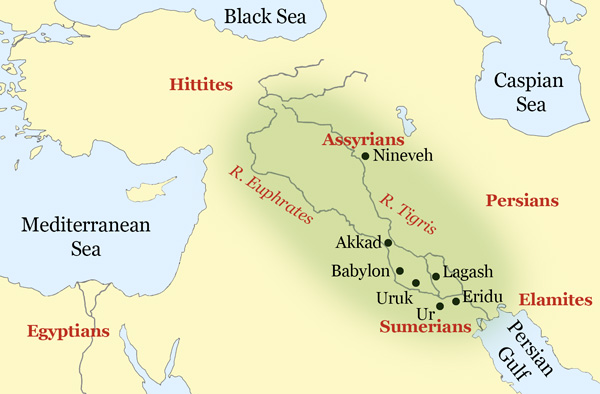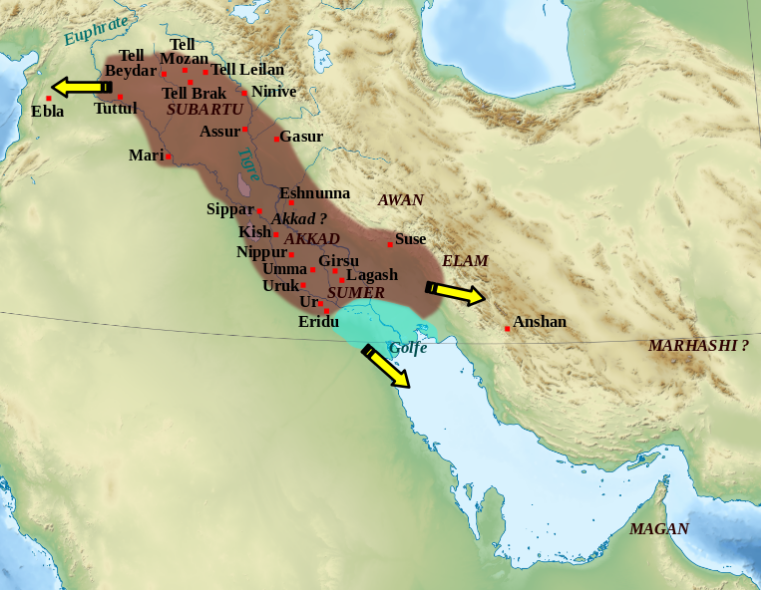The first Mesopotamian Empire, known as the Akkadian Empire, holds a significant place in ancient history. Its rise and dominance in the region were truly remarkable.
The Akkadian Empire, founded by Sargon the Great around 2334 BCE, was the first known empire to govern a large-scale empire in Mesopotamia. It stretched from modern-day Iraq to Syria and Iran, covering a vast territory.
The first Mesopotamian empire was the Akkadian Empire, founded by Sargon of Akkad in the 24th century BCE. It was the first empire to unite the city-states of Mesopotamia under a single ruler, establishing a centralized government and expanding its territory through military conquests. Sargon’s reign marked a significant shift in Mesopotamian history, paving the way for future empires such as Babylon and Assyria.

Contents
- The Formation of the First Mesopotamian Empire
- The Legacy of the First Mesopotamian Empire
- The Origin of the First Mesopotamian Empire
- Key Takeaways – What Was the First Mesopotamian Empire
- Frequently Asked Questions
- 1. What factors led to the rise of the first Mesopotamian empire?
- 2. How did the Akkadian Empire impact the region?
- 3. How long did the first Mesopotamian empire last?
- 4. What were the major achievements of the first Mesopotamian empire?
- 5. How did the fall of the first Mesopotamian empire impact the region?
- Ancient Mesopotamia 101 | National Geographic
The Formation of the First Mesopotamian Empire
Mesopotamia, meaning the “land between the rivers,” was an ancient region located in the eastern Mediterranean bounded by the Tigris and Euphrates Rivers. The first Mesopotamian empire emerged in this region, laying the foundation for future civilizations. This article explores the unique aspects of the formation of the first Mesopotamian empire, shedding light on its political, social, and economic structures.
Early City-States in Mesopotamia
Before the rise of the first Mesopotamian empire, the region was inhabited by various city-states. These city-states, often centered around a major urban area, served as independent political entities with their own rulers, laws, and systems. Examples of such city-states include Uruk, Ur, and Eridu.
The city-states of Mesopotamia were characterized by advanced urban planning, impressive architecture, and complex social and economic systems. They were centers of trade, where goods and services were exchanged both within the city and with neighboring regions. Additionally, these city-states had their own unique cultural expressions, such as art, literature, and religious beliefs.
Over time, some city-states began to exert dominance over others, leading to conflicts and power struggles. It was within this context that the first Mesopotamian empire was formed. The emergence of a centralized authority marked a significant shift in the political and social landscape of Mesopotamia.
The first Mesopotamian empire, known as the Akkadian Empire, was established by Sargon of Akkad in the 24th century BCE. Sargon united several city-states under his rule, creating a vast empire that spanned much of Mesopotamia. Through military conquests and political alliances, Sargon was able to establish a centralized government, marking the beginning of the first Mesopotamian empire.
Political Structure and Administration
The political structure of the first Mesopotamian empire was characterized by a strong centralized authority. At the top of the hierarchy was the emperor, who held absolute power and was considered divine. The emperor was responsible for making laws, governing the empire, and ensuring the welfare of the people.
Beneath the emperor were high-ranking officials, such as governors and regional administrators, who were appointed to oversee the various territories within the empire. They were responsible for collecting taxes, maintaining order, and overseeing infrastructure projects.
The administration of the empire was organized into different departments, each with its specific responsibilities. These departments included the treasury, military, agriculture, and justice. The empire also had a system of laws and regulations that governed the behavior of its citizens.
One of the key features of the political structure was the use of cuneiform writing, a system of wedge-shaped characters impressed on clay tablets. This form of writing allowed for the recording of laws, edicts, and administrative documents, ensuring the smooth functioning of the empire.
Economic System and Trade
The first Mesopotamian empire had a complex economic system that supported its vast territories. Agriculture was the mainstay of the economy, with the fertile land between the Tigris and Euphrates rivers providing abundant resources for farming. Crops such as wheat, barley, and dates were cultivated, while animals such as sheep and goats were raised for meat and wool.
Trade was also a crucial component of the empire’s economy. The extensive river networks allowed for the transportation of goods, facilitating trade between different regions. Mesopotamia was rich in natural resources such as timber, stone, and metals, which were sought after by neighboring civilizations.
The empire engaged in long-distance trade, importing and exporting goods with regions as far as the Indus Valley and Egypt. Traders would travel along established trade routes, exchanging goods such as textiles, precious metals, pottery, and spices. Trade brought wealth and cultural exchange, contributing to the prosperity of the empire.
To facilitate trade and economic activities, the empire developed a system of weights and measures. Standardized units ensured fairness in transactions and created a sense of trust among traders. Additionally, the empire had a sophisticated banking system that involved the use of silver and copper as a medium of exchange.
Social Structure and Cultural Development
The first Mesopotamian empire had a hierarchical social structure that was primarily determined by birth and occupation. At the top of the social pyramid were the ruling elite, including the emperor, nobles, and priests. They enjoyed wealth, privilege, and high social status.
Beneath the ruling elite were the free citizens, who were artisans, merchants, and farmers. They had more rights and freedoms compared to the lower classes. Slavery was also prevalent, with slaves being primarily prisoners of war or individuals who were unable to pay their debts.
Religion played a significant role in the social and cultural life of the empire. The Mesopotamians believed in a pantheon of gods and goddesses, each associated with different aspects of life. Temples were constructed as religious centers, where priests performed rituals and ceremonies to ensure the favor and protection of the gods.
Art and literature thrived in the first Mesopotamian empire. The empire produced intricate works of art, including sculptures, jewelry, and pottery. Cuneiform writing allowed for the creation of epic poems, hymns, and historical accounts, providing valuable insights into the culture and traditions of the empire.
The Legacy of the First Mesopotamian Empire
The first Mesopotamian empire laid the foundation for future civilizations in the region. Its political, social, and economic structures became the template for subsequent empires and kingdoms in Mesopotamia and beyond. The empire’s achievements in administration, trade, and culture had a lasting impact on the development of human civilization.

The Origin of the First Mesopotamian Empire
The first Mesopotamian Empire, known as the Akkadian Empire, emerged in the ancient region of Mesopotamia around 2334 BCE. It was founded by Sargon of Akkad, a legendary ruler who unified neighboring city-states under his rule. The Akkadian Empire is considered the first true empire in history, as it encompassed a vast territory that stretched from modern-day Iraq to parts of Iran, Syria, and Turkey.
Sargon of Akkad established a centralized administration, creating a powerful and efficient bureaucratic system to govern his empire. He also created a standing army, which allowed him to conquer neighboring lands and expand his empire’s borders. The Akkadian Empire thrived economically, with trade routes connecting Mesopotamia to distant regions.
The Akkadian Empire had a significant cultural impact, with the Akkadian language becoming the lingua franca of the region. Its influence on subsequent Mesopotamian civilizations, such as the Babylonians and Assyrians, cannot be overstated. However, the empire’s decline began around 2193 BCE, attributed to internal conflicts, invasions, and environmental factors like droughts and agricultural decline.
###
Key Takeaways – What Was the First Mesopotamian Empire
- The first Mesopotamian empire was the Akkadian Empire, founded by Sargon of Akkad.
- The Akkadian Empire emerged around 2334 BCE and lasted for over 200 years.
- The empire was known for its centralized government and military conquests.
- Sargon of Akkad is considered the first emperor in history.
- The Akkadian Empire paved the way for future Mesopotamian empires like the Babylonian and Assyrian empires.
Frequently Asked Questions
Mesopotamia, which means “land between the rivers,” was an ancient region in the eastern Mediterranean. It is considered one of the cradles of civilization, where the first city-states and empires emerged. The first Mesopotamian empire played a significant role in shaping the region’s history. Here are some commonly asked questions about it:
1. What factors led to the rise of the first Mesopotamian empire?
The first Mesopotamian empire, known as the Akkadian Empire, rose to power around 2334 BCE. Several factors contributed to its rise, including:
First, the Akkadians, led by their ambitious king Sargon, united the city-states of Mesopotamia under a single ruler, creating a centralized government. Second, their military conquests, combined with advancements in weapons and warfare tactics, helped them expand their territory. Third, the empire established a system of administration and trade that promoted economic growth.
2. How did the Akkadian Empire impact the region?
The Akkadian Empire was the first major empire in Mesopotamia, and its influence was significant. Some impacts of the Akkadian Empire include:
Politically, the empire set a precedent for future empires by centralizing power and establishing a system of administration. This administrative system became a model for future empires in the region. The empire also facilitated cultural exchange and the spread of Akkadian as a lingua franca, influencing the development of Mesopotamian culture and language.
3. How long did the first Mesopotamian empire last?
The Akkadian Empire, considered the first Mesopotamian empire, lasted for approximately 180 years, from 2334 BCE to 2154 BCE. It was eventually overthrown and collapsed due to internal conflicts and external invasions.
4. What were the major achievements of the first Mesopotamian empire?
The first Mesopotamian empire, the Akkadian Empire, had several major achievements, including:
– Unifying the city-states of Mesopotamia under a single ruler
– Expanding the empire’s territory through military conquests
– Establishing a centralized government and administrative system
– Promoting economic growth through trade
5. How did the fall of the first Mesopotamian empire impact the region?
The fall of the Akkadian Empire had a significant impact on the region. It resulted in a power vacuum and a period of political instability. The collapse of the empire also led to the fragmentation of Mesopotamia into smaller city-states, which often engaged in conflicts and wars for supremacy. However, the cultural and societal advancements achieved during the empire’s existence continued to influence the region for centuries to come.
Ancient Mesopotamia 101 | National Geographic
In conclusion, the first Mesopotamian empire was the Akkadian Empire, which was established by Sargon of Akkad around 2334 BCE. Sargon was a great military leader who united various city-states in Mesopotamia under his rule, creating the first empire in history.
The Akkadian Empire lasted for about 200 years and had a significant impact on the development of Mesopotamian civilization. It paved the way for future empires in the region, such as the Babylonian and Assyrian empires, and it introduced many innovations, including the first known postal system and the Akkadian language as a lingua franca.